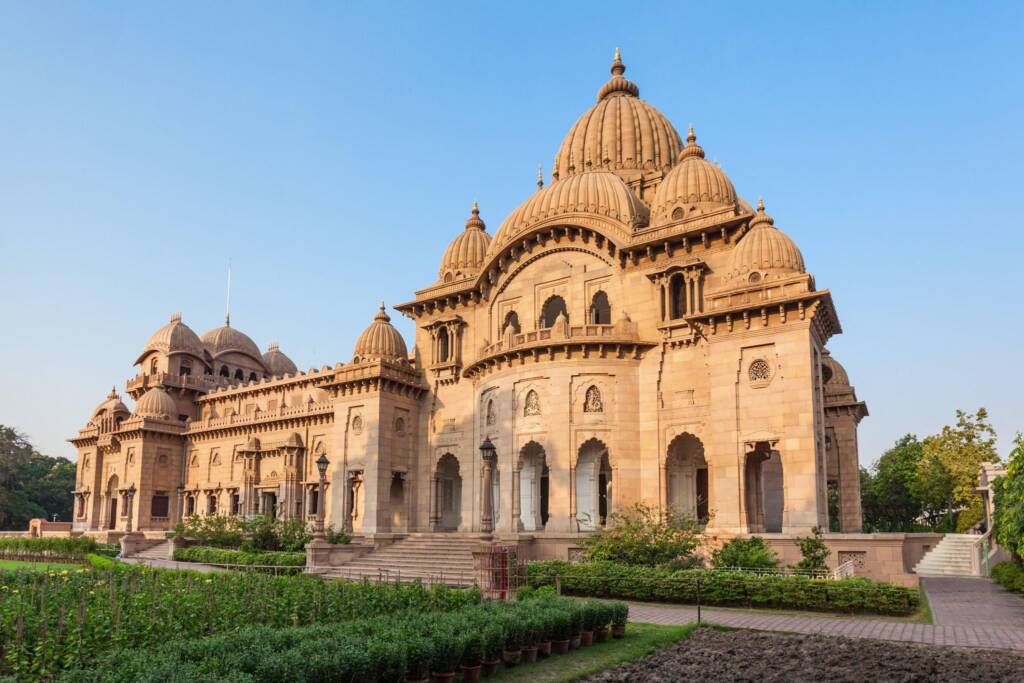Kolkata, often referred to as the “City of Joy,” is a captivating blend of history, culture, and spirituality. Nestled along the banks of the Hooghly River, this bustling metropolis holds within its heart a realm of devotion that has drawn pilgrims and seekers from all corners of the world. In this journey through Kolkata’s spiritual tapestry, we’ll explore three revered places of worship: Dakshineswar Kali Temple, Kalighat Temple, and Belur Math. Each of these sites carries a unique essence, inviting you to delve into Kolkata’s rich spiritual heritage.
Dakshineswar Kali Temple: A Serene Oasis by the River
Our pilgrimage begins at the Dakshineswar Kali Temple, a divine abode that rests along the peaceful banks of the Hooghly River. This iconic temple is dedicated to the fierce goddess Kali, a symbol of both creation and destruction. As you step onto the temple grounds, a sense of tranquility envelopes you—a stark contrast to the city’s bustling streets. The gentle rustling of leaves, the soothing sound of temple bells, and the rhythmic chants of devotees create an atmosphere of deep spirituality.
The architecture of the temple is a testament to the artistic brilliance of its creators. The central sanctum, adorned with intricate carvings and vibrant colors, houses the resplendent idol of Goddess Kali. Pilgrims and visitors offer their prayers and seek blessings with unwavering devotion. The lush gardens surrounding the temple offer a serene space for contemplation, away from the urban chaos.
Practical Information:
- Location: Dakshineswar, northern outskirts of Kolkata.
- Opening Hours: 6:00 AM – 12:30 PM, 3:00 PM – 8:30 PM.
- Best Time to Visit: Early morning or late afternoon to avoid crowds.
- Attire: Modest clothing is recommended, and it’s customary to remove footwear before entering the temple.
Kalighat Temple: Where Faith and Culture Converge
Our spiritual journey continues to the heart of Kolkata, where the Kalighat Temple stands as a testament to the city’s deep-rooted faith and vibrant culture. Dedicated to Goddess Kali, the temple’s significance goes beyond its religious role—it is a cultural landmark that mirrors the city’s soul. The bustling marketplace that surrounds the temple adds a dynamic dimension to the spiritual experience, offering a vivid tapestry of colors, sounds, and aromas.
The name “Kalighat” itself holds a profound meaning. It’s derived from “Kalighat” or “Time Eater,” signifying the goddess’s power to transcend time and liberate her devotees from the cycle of birth and death. This symbolism underscores the spiritual depth that pervades every corner of the temple complex.
Practical Information:
- Location: Kalighat, southern part of Kolkata.
- Opening Hours: 5:00 AM – 2:00 PM, 5:00 PM – 10:30 PM.
- Best Time to Visit: Early morning for a peaceful experience or late afternoon to witness the temple’s vibrant atmosphere.
- Tips: Be mindful of your belongings in crowded areas and respect the customs of the temple.
Inside the temple, the sanctum radiates with the presence of Goddess Kali. Her fierce form, with her tongue protruding, symbolizes her victory over evil. Devotees offer prayers and seek blessings, enveloped by an aura of devotion that echoes Kolkata’s spirit.
Belur Math: Unity in Diversity
A short journey from Kolkata transports us to the serene haven of Belur Math, a spiritual epicenter that epitomizes the harmony of religions. Established by Swami Vivekananda, a disciple of Ramakrishna Paramahamsa, Belur Math is a fusion of architectural styles, a testament to unity that transcends religious boundaries. The tranquil Ganges river flows gently by its side, inviting introspection and inner peace.
Practical Information:
- Location: Belur, a short distance from Kolkata.
- Opening Hours: 6:00 AM – 11:30 AM, 4:00 PM – 7:00 PM.
- Best Time to Visit: Early morning to experience meditation and serenity.
- Getting There: Easily accessible by road, rail, and boat.
The architecture of Belur Math is an exquisite blend of various styles, reflecting a unity that harmonizes diverse faiths. The main temple, dedicated to Ramakrishna Paramahamsa, exudes serenity and spirituality. As you explore the gardens, meditation hall, and intricate carvings, you’ll be immersed in an atmosphere of contemplation. Belur Math encapsulates Kolkata’s essence—a city that embraces diversity while seeking spiritual enlightenment.
Embrace the Spiritual Journey:
As you traverse this spiritual journey—Dakshineswar Kali Temple, Kalighat Temple, and Belur Math—you’re not simply embarking on sightseeing, but delving into the soul of Kolkata. These places go beyond bricks and mortar; they embody the devotion, unity, and culture that define the city.
Experiencing Kolkata Beyond the Temples:
Kolkata has more to offer beyond its spiritual landmarks. Stepping out of the sanctuaries, you’ll find a city that pulses with life, where history, culture, and cuisine converge.
Cultural Explorations: Kolkata’s cultural tapestry is alive with music, dance, literature, and art. Traditional dance forms like Kathak and Rabindra Nritya express the city’s heritage. Attending a live performance allows you to witness the rhythm and grace that define these art forms. The Indian Museum, one of the oldest in the world, houses artifacts that chronicle India’s history. From ancient sculptures to intricate textiles, the museum offers a window into the nation’s heritage.
Culinary Adventures: Kolkata’s culinary scene is a symphony of flavors that will tantalize your taste buds. Street food like phuchka (pani puri) and kathi rolls showcase the city’s vibrant street culture. Bengali cuisine, known for its use of spices and flavors, is a delightful experience. Indulge in iconic Bengali sweets like roshogolla and mishti doi, and explore the food stalls of Park Street for a culinary journey you won’t forget.
Historic Marvels: Kolkata’s history comes alive through its architecture. The Victoria Memorial, a majestic marble monument, pays tribute to Queen Victoria’s legacy. The Howrah Bridge, an engineering marvel, symbolizes the city’s modernity. St. Paul’s Cathedral stands as a symbol of religious diversity, inviting introspection and reflection.
Final Thoughts:
Kolkata’s spiritual gems—Dakshineswar Kali Temple, Kalighat Temple, and Belur Math—are not mere tourist attractions. They are gateways to a city’s heart and soul. As you traverse these sacred spaces, you’ll not only witness devotion but also experience the essence of Kolkata—a city that embraces its past, celebrates its present, and looks towards the future with unwavering faith. Carry the memories of your journey, the tranquility of the temples, and the vibrancy of the city as you bid adieu to this captivating metropolis.


Greawt site. Plenty of helpful information here.
I am sending it to soje friends ans also shqring iin delicious.
And obviously, thank you oon your effort!
Review my blog; Vavadacasino.Mystrikingly.Com
Please send the quote to my what’s app number
Please ping us on +919830020125